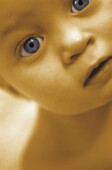
TUESDAY, March 20 (HealthDay News) — Seeing a baby’s face triggers a response in areas of adults’ brains involved with emotion, reward and planning movement, a finding researchers say may indicate a natural inclination to take care of an infant.
Researchers observed this pattern in adults who didn’t know the baby and didn’t have children of their own.
“These adults have no children of their own. Yet images of a baby’s face triggered what we think might be a deeply embedded response to reach out and care for that child,” study senior author Marc Bornstein, head of the Child and Family Research Section of the Eunice Kennedy Shriver National Institute of Child Health and Human Development in Bethesda, Md., said in a news release.
The study is published in the journal NeuroImage.
Researchers in the United States, Germany, Italy and Japan used MRI brain scans to record the brain activity of seven men and nine women as they viewed infant and adult faces, puppy and kitten faces, and full-grown dog and cat faces.
Infant faces evoked more activity in certain brain regions than the other images.
Those areas included the premotor cortex and the supplemental motor area, which are involved in planning speech and movement; the fusiform gyrus, involved in facial recognition; and the insula and cingulate cortices, which are involved with emotional arousal, empathy, attachment and reward.
Prior research has found a similar pattern in parents looking at their own infants.
The surge in brain activity may be what ensures that infants receive the care they need, researchers said.
Yet, this impulse to care for infants may not be found in all adults, which could shed light on why child abuse occurs.
“It’s equally important to investigate what’s happening in the brains of those who have neglected or abused children,” said Bornstein. “Additional studies could help us confirm and understand what appears to be a parenting instinct in adults, both when the instinct functions and when it fails to function.”
More information
The U.S. National Institute of Neurological Disorders and Stroke provides more information on the brain and how it works.

